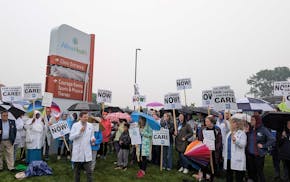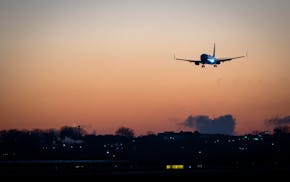The latest study on the impact of the minimum wage increases in Minneapolis and St. Paul has found that while they inevitably led to an overall bump in wages, they also allowed for a decline in hours worked and the number of jobs.
In their second series of reports on the topic, researchers at the Federal Reserve Bank of Minneapolis and the University of Minnesota waded through the tricky task of separating out the impact of the minimum wage hikes — on their way to $15 an hour — from the pandemic and the civil unrest after the murder of George Floyd.
When they released their initial findings in November 2021 showing a decrease in restaurant jobs, the researchers set aside some of the 2020 data, noting the unprecedented events of that year could have skewed it. Since then, they've updated their analysis with two more years of data and employed additional strategies to try to isolate the impacts from just the wage increases.
"I think we've addressed a lot of the skepticism using these additional approaches," said Anusha Nath, an economist at the Minneapolis Fed who conducted the study along with University professors Loukas Karabarbounis and Jeremy Lise. "That gives us confidence that we're picking up the effect of the minimum wage."
The researchers concluded that from 2018 to 2021, overall wages rose and overall hours, jobs and earnings declined by between 0.5% and 2.3% in the two cities.
The largest impacts were in the low-wage industries of retail and restaurants. In those sectors, wage increases were sometimes as high as 10%. Meanwhile, hours and jobs shrank by more than 20%, and in some cases, by more than 40% during that four-year span.
Overall, Minneapolis lost about 5,400 jobs and St. Paul lost 3,800, Nath said.
Minneapolis Mayor Jacob Frey, who supported the $15-an-hour minimum wage increase as a City Council member, noted the 10-year research project — which both cities commissioned — to study the impact of the wage increases is at its halfway point.
"This is one data point that we will certainly pay attention to along the continuum," Frey said of the newest studies released this month. "We're going to dig in and continuously analyze the data to see where it leads."
Initially, the Twin Cities researchers compared wage and job trends in Minneapolis with other cities in Minnesota. In the latest studies, they added an additional control group of other U.S. cities of similar sizes that did not have minimum wage increases. The researchers also tracked individual workers and dissected what happened to Twin Cities businesses in the same ZIP code — even on the same block — to help account for the impacts of the civil unrest.
Still, some critics are unconvinced they were able to fully account for the pandemic and civil unrest, which both led to considerable business disruption.
Michael Reich, an economics professor at the University of California, Berkeley who has studied minimum wages, said the impacts will likely vary by city.
"But their effects are just way out of line with what anyone else has found," he said of the Minneapolis Fed studies. "I think including the pandemic year is a big elephant in the room. It's very hard for them to control for the pandemic."
Nath said the Twin Cities' findings are fairly consistent with more recent research on larger changes in the minimum wage. Much of the earlier research, she said, was on much smaller changes in minimum wages.
Some economists also remain skeptical of the researchers' findings that St. Paul's minimum wage increases, which didn't start taking effect until 2020, led to job losses in 2018 and 2019 as employers anticipated the coming changes. Ben Zipperer of the Economic Policy Institute called that finding "completely implausible."
Minneapolis started phasing in its wage increases in 2018. Both cities have boosted starting pay by about $1 a year — with a different schedule for large and small businesses — on their way to $15 an hour.
Large businesses in Minneapolis reached $15 an hour in 2022; smaller employers will hit that threshold next year. St. Paul's increases will fully be in place by 2027.
In the meantime, amid a tight labor market coming out of the pandemic, many employers on their own have already raised hourly wages to $15 or higher in order to attract workers.
"Nobody is talking about $15 anymore," said Jonathan Weinhagen, president of the Minneapolis Regional Chamber, pointing to how some fast-food chains are now offering starting wages of $17 or more.
Still, he said, the study's findings are useful, especially as there will likely be future conversations about additional minimum wage increases.
Greg Nammacher, president of SEIU Local 26, which represents about 8,000 janitors, security and airport workers across the seven-county metro area, said the minimum wage increases in both cities have been a powerful tool to help the union push for sizeable raises for all its members, who are mostly people of color and immigrants.
He said some union members had been stuck at around $11 an hour for about a decade until they were finally able to negotiate for hourly raises of a few dollars. Nammacher said he hasn't seen any job losses or reductions in hours among members related to the higher pay.
Most of the union's janitorial contracts are now at $18 an hour, he said. "And it's still hard to find workers at that rate," Nammacher said.
Through the years, studies about the impact of minimum wages have pointed to different conclusions, a topic of discussion among researchers and academics at a two-day conference this week at the Minneapolis Fed and the U.
David Neumark, an economist from the University of California, Irvine, presented his review of literature on minimum wages and said a majority of studies have found some modest negative employment effects.
"That doesn't mean the minimum wage is a bad idea," he said. "It means there's a cost. It means we have to think about trade-offs."
After Seattle passed its $15-an-hour minimum wage ordinance in 2014 — a few years earlier than Minneapolis — a team of researchers at the University of Washington studied its incremental implementation.
The team's main finding was that low-wage workers in the city saw a reduction in hours that offset their wage increases, said Jacob Vigdor, a member of the research team. In one analysis, they also found a decrease in employment.
While workers might not have made much more because they worked fewer hours, he said, some workers could still find that beneficial.
"You could end up with the same money but have more time available to spend with your family or pursue your studies," Vigdor said.
The results from the Twin Cities studies so far, Vigdor added, are "broadly consistent" with what researchers found in Seattle, particularly when it comes to fewer hours worked.
"What I take away from the two studies in tandem is that there's some evidence that employers do find ways to economize on labor when labor gets more expensive," he said.
As for the Minneapolis and St. Paul studies, Nath said it's too soon to make any sweeping statements about whether the minimum wage increases have been good or bad for workers. Future studies will dig into issues such as where displaced workers went as well as the race, gender and age of workers impacted, and their findings will help provide a fuller picture.
"At this point, we will just document what we have and refrain from making any sort of value judgments," Nath said.

Bushel Boy, Minnesota's local tomato grower, sold
After 60 years, federal cuts shutting down Job Corps center in St. Paul

In a first, Minnesota doctors walk their own picket line, then hustle to see patients
It's harder to find a job this year, especially a corporate position

